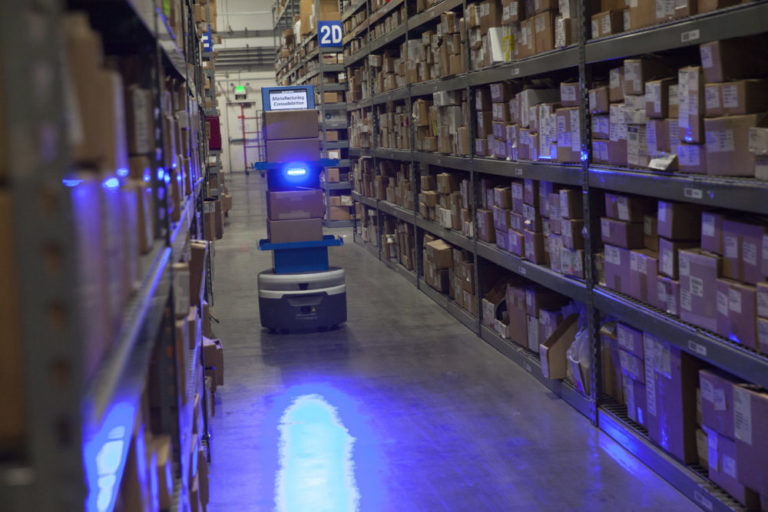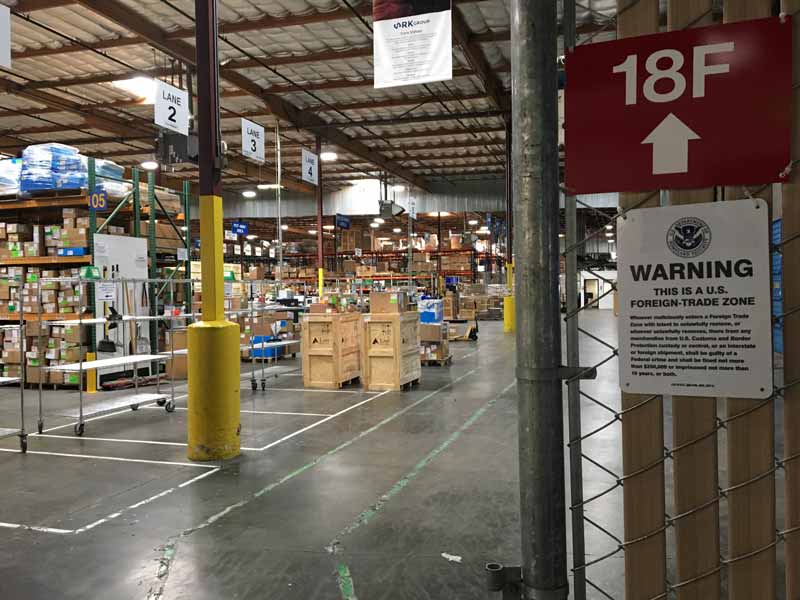RK LOGISTICS, FETCH ROBOTICS FEATURED IN SF CHRONICLE
Fetch Robotics Melonee Weis delights in showing potential of robots
The San Francisco Chronicle, San Jose, CA – Jan. 21, 2018
By Benny Evangelista, business and technology reporter Fetch Robotics CEO Melonee Wise delights in showing potential of robots When she was a child, Melonee Wise’s father bought her a “simple little robot” building kit from an educational science catalog. “You’d draw a line, and the little robot would follow the line,” Wise said. “I’ve always been a tinkerer, and I liked to build things.”
Today, she’s CEO of Fetch Robotics, a San Jose startup that’s building complex, self-driving robots that could change how warehouses operate. Her career path hasn’t always followed a straight line, and she’s endured the ups and downs of two previous robot startups. But she has emerged as a thought leader in the robotics industry, as a fresh round of financing positions her company to take advantage of the e-commerce boom.
“We’re at this tipping point with logistics and labor,” Wise, 36, said during a recent interview. “And it’s not just the United States where there’s not enough people to do the jobs. And so many businesses need to turn toward automation as a way to stay competitive, as a way to grow their businesses and, in many respects, create new jobs.”
Fetch Robotics, founded in 2014, is building robots to autonomously carry materials from one point to another inside a warehouse or other distribution building. Unlike the kinds of robots typically shown in movies and other pop culture media, Fetch’s robots don’t try to look like humans. Rather, the basic Fetch looks like a large snare drum, or a round ottoman. It’s the base to place shelves, bins or other containers that human workers fill with whatever needs to be transported. The robots know where to go, guided by cloud-based programing that can be changed depending on the need. They differ from other industrial robots that have been around for decades and are designed for specific, repetitive and stationary tasks.
Last month, Fetch Robotics landed a $25 million round of funding, its second infusion of money, led by Sway Ventures of San Francisco. It has 72 employees and plans to consolidate its office and a testing facility into one building in San Jose next month and hire more workers. Its biggest customer so far is shipping and delivery giant DHL, which last year said it completed a successful pilot project testing the robots in the Netherlands. The market for mobile warehouse robots is still in its infancy, with under $50 million in annual revenue, said Clint Reiser, director of supply chain research for ARC Advisory Group. Amazon has used warehouse robots since buying Kiva Systems, now called Amazon Robotics, in 2012, “which were brilliant for what they were doing at the time, but far from being autonomous,” said Gerald Van Hoy, an independent robotics industry analyst. “Fetch has gone much further.”
Cindy Traver, senior operations director for RK Logistics Group, said the only way her company could accommodate one major customer’s request last year to ramp up the volume of materials processed in its Livermore warehouse by about 40 percent over 90 days was to use three Fetch robots. Robots could traverse the warehouse without a break in about one minute, roughly half the time it takes for human workers, who were freed to pick up and load materials on each end. Moreover, Traver said, “When a person is walking back and forth, they’re more likely to chitchat along the way.” Wise delights in showing customers unfamiliar with robots what they can do. “One of the most gratifying moments for me when we were first starting to work with customers was when I saw someone hit the button on the display of the robot and the robot started driving,” she said. “Just the smile and the delight on their faces, that ‘Oh, it’s making my job easier’ — that was a really super cool thing to see.”
The Chicago-area native learned how to solder while building that first childhood robot, and when she was 10, she attended day camps to learn to build programmable Lego projects. At the University of Illinois at Urbana-Champaign, Wise earned a degree in physics engineering, then a master’s in mechanical engineering, “which was a dubious choice at best, because I thought mechanical engineers built robots. But I found out later that they built robots, but they don’t do the cool stuff, which is to program the robots.”
While going for a doctorate, Wise was recruited in 2007 to become one of the first employees of Willow Garage, a now-defunct Palo Alto startup that during its brief history became one of the world’s leading robotics companies for its work on self-driving cars, an autonomous solar powered boat and a personal robot. It also developed the Robot Operating System, the open-source software framework being used for robots like Fetch. Wise, who eventually became manager of robot development, said she learned from the best in robotics at Willow, although “we were doing a lot of crazy things that were not particularly directed at one specific, overarching goal.” The work at Willow spawned more focused companies “as each of us latched onto what we thought was going to be the next big thing,” she said. “What I latched onto was the logistics and manufacturing market.”
In February 2013, Wise and three fellow engineers co-founded Willow spin-off Unbounded Robotics of Santa Clara. After developing its first robot, the company became what ABI Research called “an industry darling,” but needed further financing to continue. Wise said Unbounded had an acquisition offer from an unnamed company, but the deal was scuttled by intellectual property problems in its “really bad spin-off” agreement with Willow. The terms scared away potential acquirers and investors, according to Wise. “We couldn’t take the acquisition offer, so we had to shut down the company” in August 2014, she said. It was a valuable lesson in entrepreneurship.
“I like to joke that in an 18-month period, I experienced pretty much everything that a startup founder could go through, and I got it all out of the way,” Wise said. “I learned the difference between friendship and business, (about) getting it in writing, finding a good lawyer.” Willow Garage founder Scott Hassan, now CEO of another spin-off, Suitable Technologies, did not respond to a request for comment. Wise is among a “really rare breed” of CEOs, said Andra Keay, managing director of the nonprofit industry group Silicon Valley Robotics. “There are very few serial robotics entrepreneurs,” Keay said. “That’s something the robotics industry is missing. We’re starting to see CEOs in robotics that have done another company.” She said Wise has become a visionary in the industry by focusing on areas that robots can help now rather than potentially help in the future. “There are a lot of robots that meet a public imagination rather than a pragmatic purpose,” Keay said.
Wise is also a “rising star” in an industry that’s about 90 percent male, said Jeff Burnstein, president of the Association for Advancing Automation, an umbrella trade organization that includes the Robotic Industries Association. “She’s been speaking out about the need for diversity, getting more women involved in an industry that has traditionally been male dominated,” he said.
Wise said the lack of diversity in robotics “is more than a personal challenge. We need a diversity of opinions and perspectives in order to make the best business decisions and build the best robot companies.” The lack of diversity in technology in general “has to be fixed when kids are still in elementary school,” she said. “That’s where girls are getting the wrong messages about what they can and cannot do. For girls in particular, a lot of robotics comes down to math and programming. Pay attention to those subjects, and don’t take no for an answer when someone says you can’t do it.”



